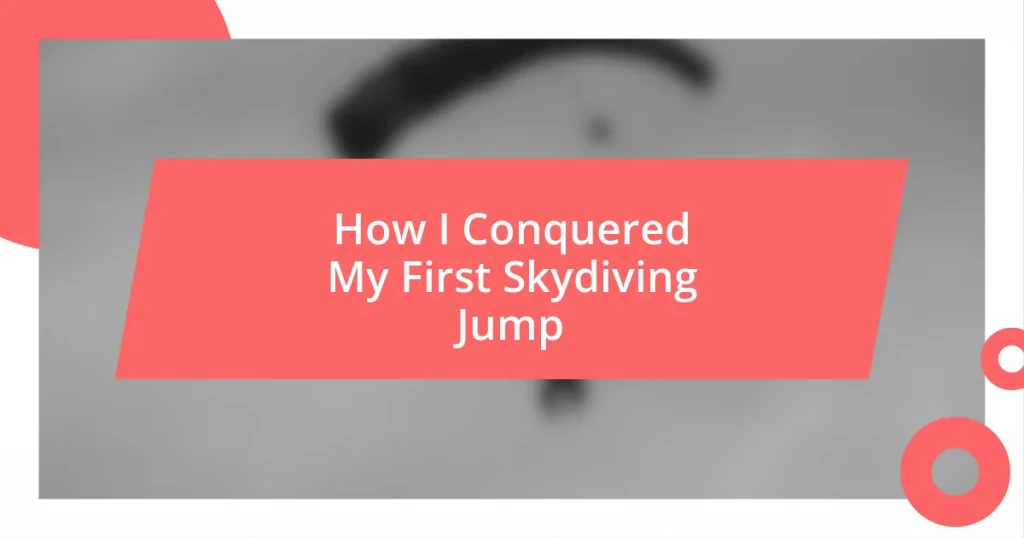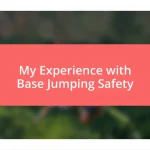Key takeaways:
- Preparation is crucial: Internalizing safety procedures and practicing mental techniques can transform fear into confidence.
- Choosing a reputable skydiving school enhances the experience: Key factors like certifications, instructor experience, and safety records are vital.
- Overcoming fear can lead to personal transformation: Acknowledging fears, visualizing success, and breaking down the process into manageable steps empower individuals to embrace adventure.
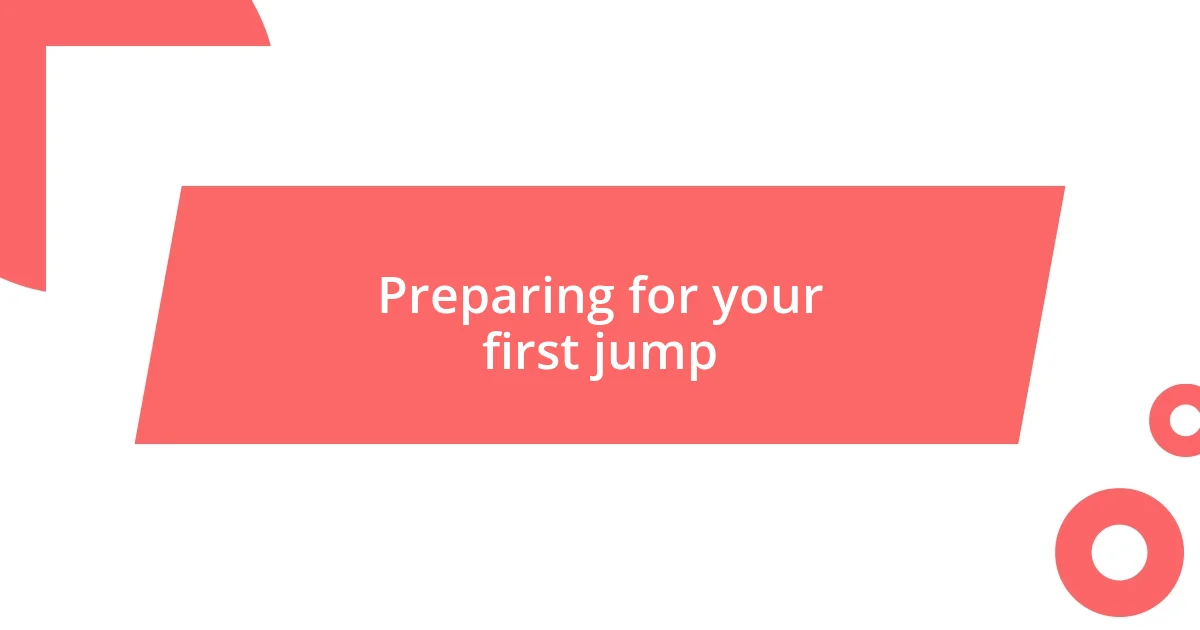
Preparing for your first jump
Preparing for my first skydive was both thrilling and nerve-wracking. I remember standing in the hangar, my heart racing as I watched experienced jumpers glide gracefully back to the ground. Have you ever felt that mix of excitement and fear? It’s a classic emotional cocktail that I think many first-timers experience.
I soaked in every detail during the pre-jump briefing. The instructor spoke passionately about safety procedures, which, surprisingly, calmed my nerves. I found myself nodding along while wondering if I would actually remember everything once I was up there. The reality is, being well-prepared is not just about listening—it’s about truly internalizing what you’re being taught.
As the moment drew closer, I had to confront my own doubts. Would I remember to look up at the parachute once I jumped? The night before, I practiced my breathing techniques, envisioning each step of the jump. It felt like a mental rehearsal that was essential to my preparation. Embracing this discomfort was crucial—I learned that facing those fears head-on only empowered me further.
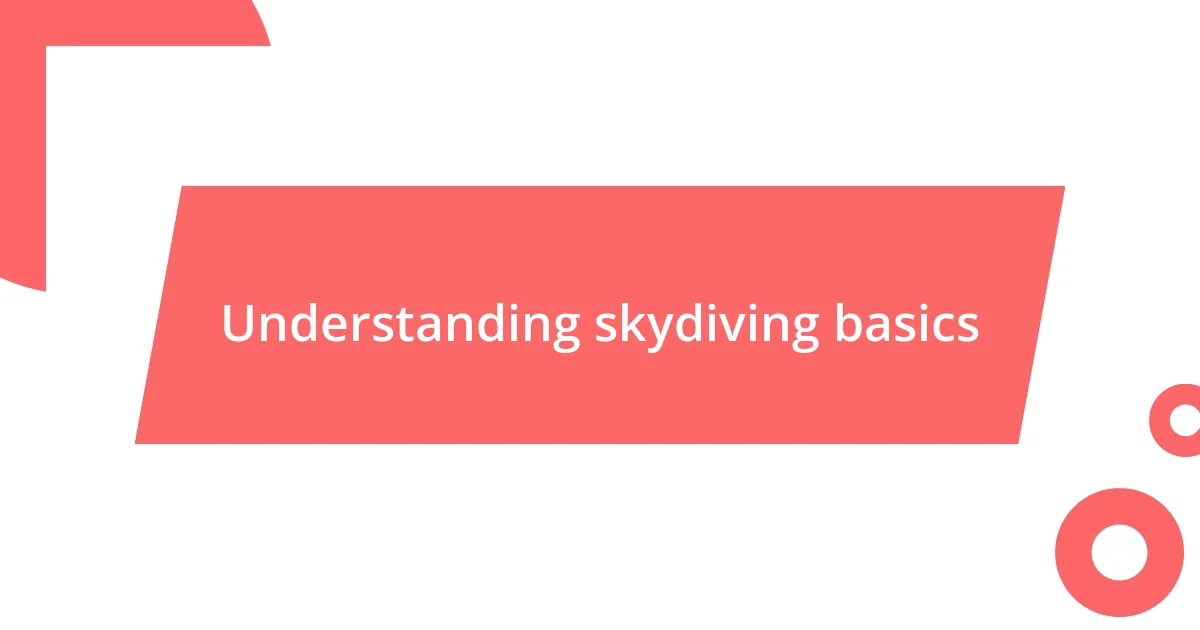
Understanding skydiving basics
Understanding skydiving basics involves getting a grasp of a few key concepts that ensure safety and enjoyment. Skydiving is essentially jumping from an aircraft and free-falling before deploying a parachute to descend safely to the ground. I still recall that moment when I learned about the importance of altitude awareness; knowing when to pull the parachute is a game-changer, as making that decision can significantly affect the landing experience.
The gear is another fundamental aspect. During my training, I was introduced to the parachute system, which includes the main parachute, a reserve parachute, and an automatic activation device (AAD). I remember feeling amazed by the technology involved! The AAD, for instance, is designed to automatically deploy the reserve parachute if you reach a certain altitude without deploying the main chute. That level of safety gave me a sense of confidence, knowing I wasn’t solely relying on my actions.
Finally, let’s not overlook the significance of body posture during free fall. When I jumped, I distinctly remembered the instructor emphasizing the “banana position” — arching your back and keeping your limbs extended. This position stabilizes your fall and produces a smoother landing. It’s all about trusting the process and knowing that even the simplest adjustments can have a huge impact on your experience.
| Skydiving Component | Description |
|---|---|
| Free Fall | Falling freely from an aircraft before parachute deployment. |
| Equipment | Includes main parachute, reserve parachute, and AAD. |
| Body Position | Proper posture (banana position) for stability during descent. |

Choosing the right skydiving school
Choosing the right skydiving school can make a world of difference in your experience. I’ll never forget the mixed feelings I had when selecting a school. One gym’s website looked flashy but lacked depth on safety. On the other hand, another school had a straightforward site filled with testimonials and a clear focus on training methodologies that shouted reliability. That’s when I realized—pay attention to the subtle cues; they tell you more than flashy graphics ever could.
Here are some essential factors to consider when making your decision:
- Certifications and Ratings: Ensure the school has proper certifications from recognized organizations, like the United States Parachute Association (USPA).
- Instructor Experience: Look into the instructors’ backgrounds. I felt more at ease when I learned my instructor had completed thousands of jumps.
- Safety Record: A school’s safety history can provide peace of mind. I read through reviews and found a school with an excellent safety record, which boosted my confidence.
- Facilities and Equipment: First-class gear is essential. Walk in and take a look; it should feel professional and well-maintained.
- Student Testimonials: Positive accounts from others can be incredibly reassuring. I found a heartfelt testimonial from a first-timer who almost canceled but decided to go through with it—the support really made a difference.
By weighing these factors, I distinctly felt more prepared and excited for my first jump. It’s amazing how knowing I chose the right school helped turn my anxiety into pure excitement!
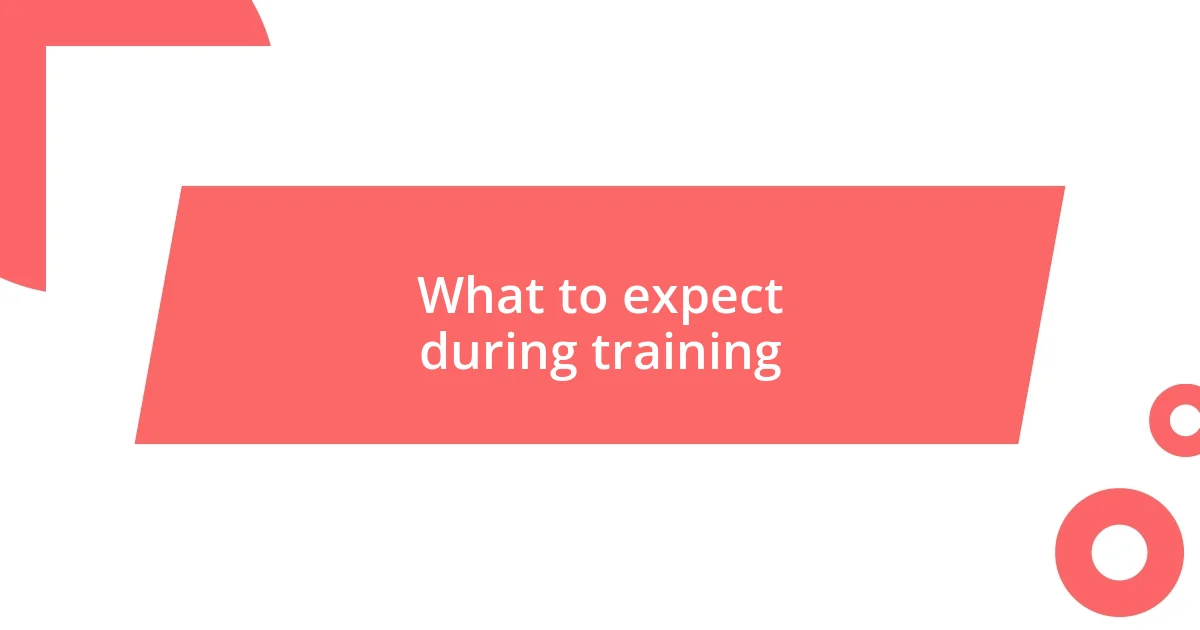
What to expect during training
I still remember my nerves the first time I walked into the training room. The instructor began with a thorough overview of safety protocols, and it hit me—this wasn’t just fun; it was serious business. I felt a mixture of excitement and anxiety, but I quickly realized that this structured environment would help ground me as I prepared to leap from a plane.
As we donned our harnesses, I couldn’t help but notice how important teamwork was in training. I was paired with a fellow novice who shared my apprehension. Sharing our fears made the experience less intimidating, and our instructors encouraged us to communicate openly about what we were feeling. It was reassuring to know we weren’t alone in this journey—after all, who hasn’t had that nagging question in their mind, “What am I really getting myself into?”
The practice jumps on the simulator were eye-opening. I vividly recall the moment my instructor guided me through the free-fall position. At first, I felt clumsy, but then I embraced the motion, thinking, “This is just the beginning.” That moment marked a shift; my confidence grew as I learned to trust both the equipment and my training. It dawned on me that every step, every drill, was a building block toward my first jump.
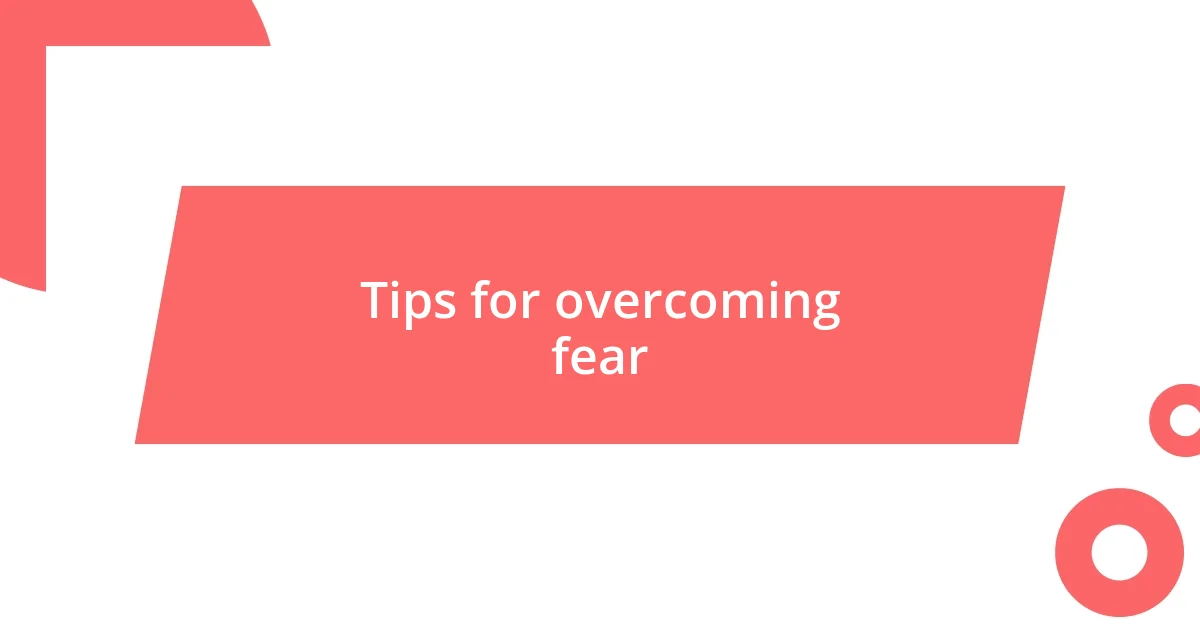
Tips for overcoming fear
The first step in overcoming fear is acknowledging it. I found that when I admitted to myself how scared I was, it somehow took away some of the power that fear held over me. Have you ever noticed how speaking your fears out loud can lessen their intensity? By sharing my anxiety with friends and family before my jump, I felt this awesome wave of support wash over me, which was incredibly uplifting.
Another helpful tip is to visualize success. I remember lying in bed the night before my jump, imagining myself soaring through the sky, arms wide and heart racing in joy rather than fear. Visualization turned my anxiety into anticipation. It’s like planning a party in your mind—by picturing every detail, you help make the actual experience easier to handle. Could you imagine your dream skydive? Paint that picture vividly and let it motivate you.
Finally, breaking your fear into smaller, manageable steps can be a game changer. Instead of focusing on the leap itself, I concentrated on each part of the process leading up to it—meeting the instructors, getting fitted for gear, and running through training drills. I found that each small win built my confidence, and before I knew it, standing at the open door of the plane felt like the natural next step rather than an insurmountable challenge. What if you approached your fear this way? You might surprise yourself with how quickly you can build momentum and courage.

The jump experience explained
The moment I sat in the plane, I could hardly believe I was actually about to skydive. With the roar of the engines and the rush of wind, my heart was pounding in a way I’d never experienced before. I still remember glancing at my instructor, who offered a reassuring nod—it was like he could sense my nerves, and his calmness radiated through me. Have you ever been in a situation where someone else’s confidence helped ground you?
As we climbed higher, the anticipation mixed with a fresh wave of fear. Peering out of the door at the sprawling landscape below, I thought about everything I had prepared for. It felt surreal at that moment, as if time had slowed down. Why was I doing this? That question echoed in my mind, and honestly, I was reminded of why I’d started— to conquer my fears and embrace adventure. The second before I jumped, I felt like I was teetering on the edge of possibility.
Then, it happened. The world dropped away as I leaped into the open sky, and for that brief moment, I was weightless. The rush of air enveloped me, and surprisingly, I experienced pure exhilaration rather than fear. I could feel every part of me coming alive in that free fall, the adrenaline coursing through my veins. Have you ever wished for a feeling that made you feel so free? In that seconds-long descent, I realized the jump was about more than just the thrill; it was about liberation—a moment to embrace all that life has to offer.
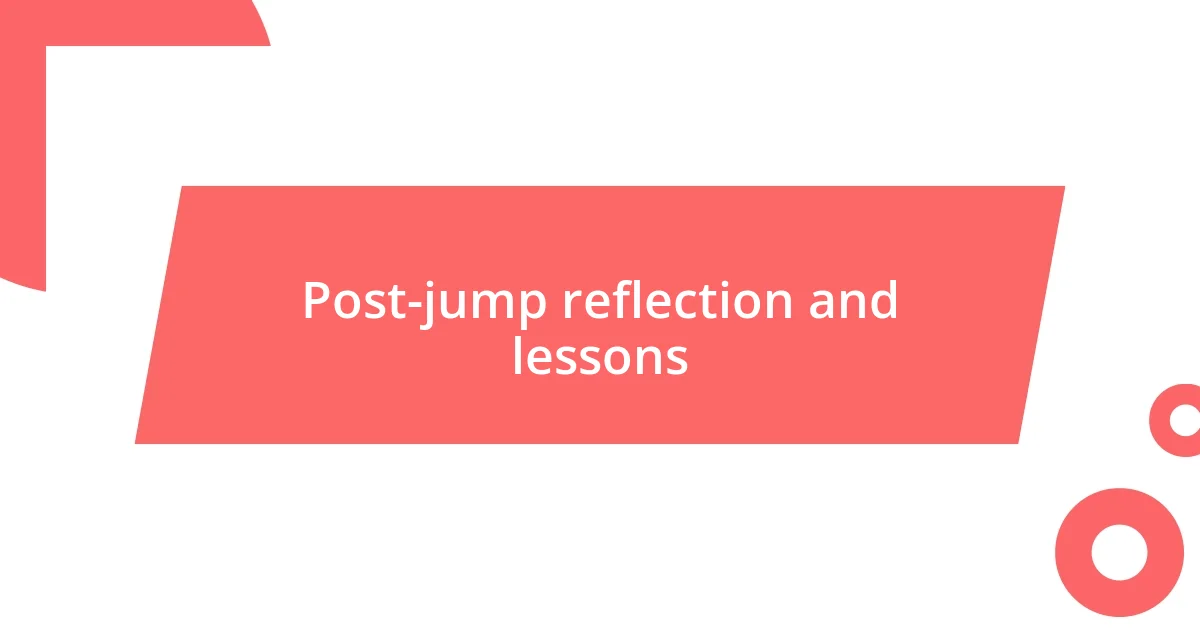
Post-jump reflection and lessons
The moment I landed, I felt a rush of emotions flood over me. It was as if a weight had been lifted off my shoulders. I remember pulling off my helmet and gazing up at the sky, feeling a strange mix of disbelief and pride. Did you ever have a moment when you realized just how powerful you truly are? For me, that was my skydiving jump—it was a reminder that fear is conquerable.
Reflecting on my experience, I realized how vital it is to savor the moment of triumph. After the adrenaline wore off, I took time to appreciate the sheer beauty of the world from a new perspective. It struck me how life often keeps us grounded in mundane routines, while this one jump catapulted me into a realm of excitement and possibility. How often do we let fear hold us back from exploring the extraordinary?
One crucial lesson I took away was the importance of resilience. I learned that every fear can be transformed into courage through preparation and mindset. I still think back to that day, to how my heart raced, and I smile, knowing I not only faced my fear but also embraced an incredible adventure. What challenges are you willing to face head-on? You might surprise yourself with what lies on the other side.










